
A kurgan is a type of tumulus constructed over a grave, often characterized by containing a single human body along with grave vessels, weapons and horses. Originally in use on the Pontic–Caspian steppe, kurgans spread into much of Central Asia and Eastern, Southeast, Western and Northern Europe during the 3rd millennium BC.

The Dnieper, also called Dnipro, is one of the major transboundary rivers of Europe, rising in the Valdai Hills near Smolensk, Russia, before flowing through Belarus and Ukraine to the Black Sea. Approximately 2,200 km (1,400 mi) long, with a drainage basin of 504,000 square kilometres (195,000 sq mi), it is the longest river of Ukraine and Belarus and the fourth-longest river in Europe, after the Volga, Danube, and Ural rivers.
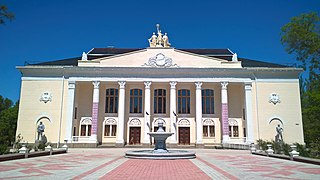
Nova Kakhovka is a city in Kakhovka Raion, Kherson Oblast, southern Ukraine. Nova Kakhovka has been under Russian occupation since February 2022. Its estimated population in 2022 was 44,427.

Kherson Oblast, also known as Khersonshchyna, is an oblast (province) in southern Ukraine. It is located just north of Crimea. Its administrative center is Kherson, on the northern or right bank of the Dnieper river, which bisects the oblast. The oblast has an area of 28,461 km2 and a population of 1,001,598. It is considered the 'fruit basket' of the country, as much of its agricultural production is dispersed throughout the country, with production peaking during the summer months.
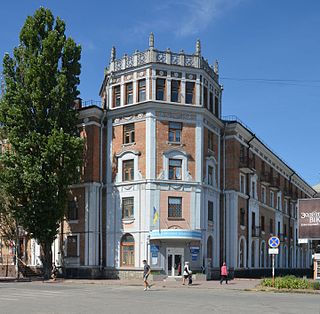
Nikopol is a city and municipality (hromada) in Nikopol Raion in the south of Ukraine, on the right bank of the Dnieper River, about 63 km south-east of Kryvyi Rih and 48 km south-west of Zaporizhzhia. Population: 105,160.
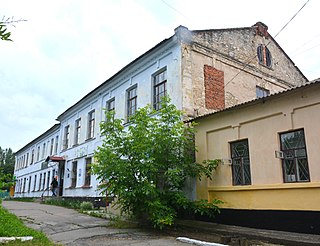
Kakhovka is a port city on the Dnieper River in Kakhovka Raion, Kherson Oblast, of southern Ukraine. It hosts the administration of the Kakhovka urban hromada, one of the hromadas of Ukraine. It had a population of 34,749

Oleshky, previously known as Tsiurupynsk from 1928 to 2016, is a town in Kherson Raion, Kherson Oblast, southern Ukraine, located on the left bank of the Dnieper River with the town of Solontsi to the south. It is the oldest city of the oblast and one of the oldest in southern Ukraine. It is known for its proximity to the Oleshky Sands, a large desert region. Oleshky is the site of artist Polina Rayko's home, a national cultural monument of Ukraine. It also hosts the administration of Oleshky urban hromada, one of the hromadas of Ukraine. It had a population of 24,124.

Beryslav is a city in Kherson Oblast, southern Ukraine. It serves as the administrative center of Beryslav Raion, housing the district's local administration buildings. Beryslav hosts the administration of Beryslav urban hromada, one of the hromadas of Ukraine. Population: 11,895.
Tavriisk is a small city in Kakhovka Raion, Kherson Oblast, southern Ukraine, close to the city of Nova Kakhovka. It is located on the left bank of the Dnieper River. Tavriisk hosts the administration of the Tavriisk urban hromada, one of the hromadas of Ukraine. It has a population of 10,108.

Enerhiya Nova Kakhovka was a Ukrainian professional football team from Nova Kakhovka in Kherson oblast. The club competed in the Ukrainian Second League since 2010.
Chaplynka is an urban-type settlement in Kakhovka Raion, Kherson Oblast, southern Ukraine. It hosts the administration of the Chaplynka settlement hromada, one of the hromadas of Ukraine. It had a population of 9,415. In early 2022, it came under Russian occupation as a result of the Russian invasion of Ukraine.
The Ministry of Culture and Information Policy (MCIP) is the main state authority in the system of central government of Ukraine responsible for ensuring the informational sovereignty of Ukraine, in particular regarding the dissemination of socially important information in Ukraine and beyond, as well as ensuring the functioning of state information resources and country's cultural development and history preservation. It is fully based on the former Ministry of Culture and Tourism. The Honcharuk Government merged the Ministry of Youth and Sports, established on February 28, 2013, and the Ministry of Culture (MinCult), established on December 9, 2010, into the Ministry of Culture, Youth and Sports. But its succeeding Shmyhal Government undid this merger, separating the Ministry of Youth and Sports into a separate body, and the Ministry of Culture, Youth and Sports on 23 March, 2020 will be renamed the Ministry of Culture and Information Policy, joining the Ministry of Information Policy, which operated from 2 December 2014 to 29 August 2019.

The North Crimean Canal is a land improvement canal for irrigation and watering of Kherson Oblast in southern Ukraine and the Crimean Peninsula. The canal has multiple branches throughout Kherson Oblast and Crimea.
Novovorontsovka is an urban-type settlement in Beryslav Raion, Kherson Oblast, southern Ukraine. It hosts the administration of Novovorontsovka settlement hromada, one of the hromadas of Ukraine. Novovorontsovka is located on the right bank of the Kakhovka Reservoir, an artificial reservoir on the Dnieper. It has a population of 5,951.
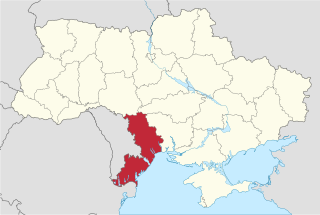
Odesa Oblast, also referred to as Odeshchyna (Одещина), is an oblast (province) of southwestern Ukraine, located along the northern coast of the Black Sea. Its administrative centre is the city of Odesa. Population: 2,351,382.

Russia began an invasion of Ukraine on 24 February 2022, in a major escalation of the Russo-Ukrainian War that began in 2014. It is the largest military attack in Europe since World War II. During the fighting, many pieces of Ukrainian cultural heritage were either destroyed, damaged, or put at risk due to the widespread destruction across the country. This deliberate destruction and looting of over 500 Ukrainian cultural heritage sites is considered a war crime and has been described by Ukraine's Minister of Culture as cultural genocide.
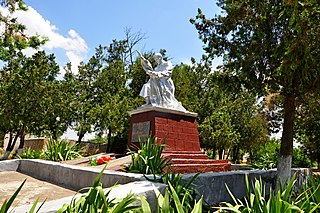
Tiahynka is a village (selo) in Beryslav Raion, Kherson Oblast, southern Ukraine. Tiahynka hosts the administration of the Tiahynka rural hromada, one of the hromadas of Ukraine. In 2021, it had a population of 2,031.
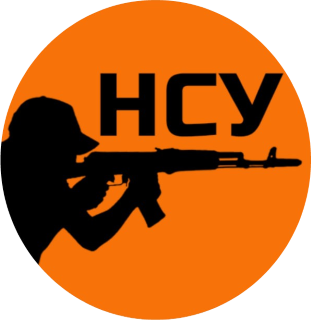
Popular Resistance of Ukraine is a Ukrainian underground partisan organization operating in the territories of Ukraine occupied by Russian troops during the 2022 invasion of the country. The partisans operate in the rear and transmit the coordinates of important military facilities and the deployment of Russian troops to the Armed Forces of Ukraine.

The Kherson Art Museum is an art museum in Kherson, Ukraine. It is housed in Kherson's former city hall building. The museum opened on 27 May 1978.

During the Russian invasion of Ukraine (2022-ongoing), Russian forces and organizations have stolen and looted tens of thousands of art pieces from Ukraine, ranging from modern art to ancient Scythian gold. The Russians have also destroyed hundreds of cultural sites and monuments. The looting has been organized, with, in some cases, Russian art experts participating in the theft, and directing Russian soldiers as to which pieces to steal. In Mariupol alone, Russians stole over 2,000 works of art from the city's three main museums, after Russian forces occupied the city after a three month siege in May 2022. In the Kherson region, shortly before fleeing the area to the north of the Dnieper river Russians destroyed, either fully or in part, over 200 Ukrainian cultural sites and stole around 10,000 art pieces from the city's museums, out of a collection of 13,000. Other sources put the number of stolen art works from Kherson alone at 15,000.

















